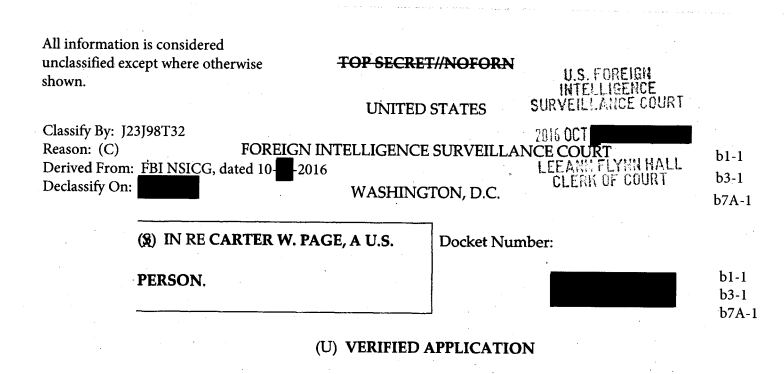What to Make of the Carter Page FISA Applications
The release of the Carter Page FISA applications represents a monumental disclosure to the public—and underlines just how disingenuous House intelligence committee Chairman Devin Nunes has been.

Published by The Lawfare Institute
in Cooperation With

The Carter Page FISAs are out via the Freedom of Information Act. Here are a few observations, relatively brief but still just a bit too long for Twitter.
First, a huge amount of information is redacted in these FISA applications, but they still represent a monumental disclosure to the public. The government considers FISA applications to be very sensitive—and their disclosure, even heavily redacted, may have long-term, programmatic consequences long after we’re finished with President Trump. The government seems to have accepted that FOIA applies to FISA. Without taking a position on the issue it made me recall this Lawfare post that argues to the contrary.
Second, for those who don’t remember, the controversy about these FISA applications first arose in February when House intelligence committee Chairman Rep. Devin Nunes released a memo claiming that the FBI misled the FISA Court about Christopher Steele, the former British secret agent who compiled the “dossier” on Trump-Russia ties and who was a source of information in the FISA applications on Page. The main complaint in the Nunes memo was that FBI whitewashed Steele—that the FISA applications did not “disclose or reference the role of the DNC, Clinton campaign, or any party/campaign in funding Steele’s efforts, even though the political origins of the Steele dossier were then known to senior and FBI officials.”
In response to the Nunes memo, the Democrats on the committee released their own memo. That memo quoted from parts of the FISA applications, including a footnote in which the FBI explained that Steele was hired to “conduct research regarding Candidate #1,” Donald Trump, and Trump’s “ties to Russia,” and that the man who hired him was “likely looking for information that could be used to discredit [Trump’s] campaign.”
Based on this back and forth between the HPSCI partisans, I wrote on Lawfare at the time that the FBI’s disclosures on Steele “amply satisfie[d] the requirements” for FISA applications, and that the central irony of the Nunes memo was that it “tried to deceive the American people in precisely the same way that it falsely accused the FBI of deceiving the FISA Court.” The Nunes memo accused the FBI of dishonesty in failing to disclose information about Steele, but in fact the Nunes memo itself was dishonest in failing to disclose what the FBI disclosed. I said then, and I still believe, that the “Nunes memo was dishonest. And if it is allowed to stand, we risk significant collateral damage to essential elements of our democracy.”
Now we have some additional information in the form of the redacted FISA applications themselves, and the Nunes memo looks even worse. In my earlier post, I observed that the FBI’s disclosures about Steele were contained in a footnote, but argued that this did not detract from their sufficiency: “As someone who has read and approved many FISA applications and dealt extensively with the FISA Court, I will anticipate and reject a claim that the disclosure was somehow insufficient because it appeared in a footnote; in my experience, the court reads the footnotes.” Now we can see that the footnote disclosing Steele’s possible bias takes up more than a full page in the applications, so there is literally no way the FISA Court could have missed it. The FBI gave the court enough information to evaluate Steele’s credibility.
There’s also more detail on the previous disclosure from the House intelligence committee Democrats’ memo on how Steele went to the press with the “dossier” when FBI Director James Comey sent his October 2016 letter to Congress disclosing the possible newfound importance of the Weiner laptop in the Clinton investigation. According to the FISA applications, Steele complained that Comey’s action could influence the election. But when Steele went to the press, it caused FBI to close him out as an informant—facts which are disclosed and cross-referenced in the footnote in bold text.
While I am sure people will try, my initial impression is that with all the redactions it is going to be very tough to figure out the full scope of information supporting the Court’s repeated finding of probable cause to believe that Carter Page was an agent of Russia. There is a mention of two Russians, one of whom pleaded guilty to being an unregistered agent of a foreign government and was sentenced to 30 months, but even that is disconnected from the redacted discussion that precedes it. Substantively, the government seems to have hewed as closely to the prior disclosures as it could in applying FOIA.
But it is worth noting that—and as the Democrats previously pointed out—the judges who signed off on these four FISA applications were all appointed by Republican presidents, including one George H.W. Bush appointee (Anne Conway), two George W. Bush appointees (Rosemary Collyer and Michael Mosman) and one Reagan appointee (Raymond Dearie). I know some of those judges, and they certainly are not the types to let partisan politics affect their legal judgments.


-final.png?sfvrsn=b70826ae_3)
